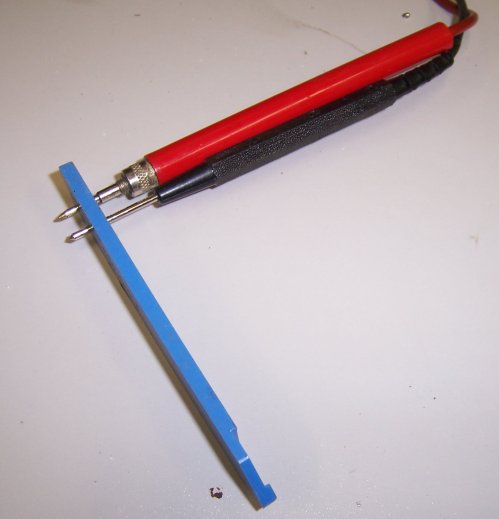
We got 10″ of new snow last night, and it’s still coming down. Given that it’s going to be a winter blunderland out on the streets today, we decided to stay inside and get a few things done closer to home. One of these things was to spend a little time measuring the resistance of coal.
Reader Joe Bryer was good enough to send me eight pounds of coal samples, in two Ziploc bags. One bag was high-quality Pennsylvania anthracite. The other was bituminous, its origins unspecified. To take the measurements, I made a jig out of a piece of scrap plastic. I drilled two .0785 holes a quarter inch apart. The distance was arbitrary. (The size of the holes is that of standard probe tips.) The idea was simply to make all measurements with the same distance between the probes.
I measured several spots on five pieces of bituminous, and in all cases the resistance was higher than my DVM’s top reading of 20 megohms. The anthracite was a completely different story. The resistance varied from place to place on any given sample, and varied widely even on a single sample. The highest readings I got were in the vicinity of 180K ohms. The lowest was 12K. I wiped the samples with a dry rag prior to testing them.
This is promising. The 1/4″ spacing between the probes was not quite arbitrary. The carbon button microphone element in an old-style telephone is about 1/4″ in size. I have several of those in the drawer and all of them tested at between 5K ohms and 10K, depending on how you orient the element, and whether you tap it with a screwdriver. It is, after all, just a little container of small carbon grains. So I think it would be worthwhile sifting some sand-sized granules of anthracite and trying them in a mic element lashup.
Joe Bryer pointed out something I hadn’t known: Bituminous and softer coals like lignite and peat are sedimentary rocks, whereas anthracite is metamorphic rock. Pressure and heat can break down some of the long carbon chains and ring hydrocarbons of which coal is made and free up the carbon, which can then, in a dense enough fragment, conduct electricity. Hydrocarbons, even very dense ones, don’t conduct electricity and many are very good insulators. Graphite, which conducts electricity very well, might be considered the highest grade of coal, or at least the variety most affected by heat and pressure underground. (It isn’t burned as fuel because it’s not common compared to coal and very difficult to ignite.)
The next thing to test is carbon from barbecue briquettes, which I will have to beg from friends since I no longer burn charcoal for grilling. If I can find some of the drafting pencil leads I used in drafting class umpty years ago, I’m going to grind them up and test them as well. (My friend Joe Flamini W4BXG says that he’s done that himself.) In the meantime, I have a place to start, and will now set my mind to building a microphone lashup to test conductive particles in. More as I manage it.











From the department of things-learned-as-a-kid-messing-around…
Placing a simple two-prong electrical plug part way into an outlet, so that the prongs are hot but still visible, and then dropping a pencil lead across them, results in (1) a big spark, (2) the lead going flying, and (3) slight notches in the lead. That was certainly the case for the old Scripto leads, almost certainly for drafting pencil leads.
Jeff, charcoal briquettes are not real charcoal like the Victorians would have had access to. They are made from sawdust mixed with some “secret recipe” binders. If you have a good BBQ pit near by maybe they would let you have a small piece of real charcoal in the interest of science.
I am sure you have probably noticed, but the early telephone transmitters show the transmitter portion as something that would sit on a table. I suspect that one of the early difficulties was getting a carbon element to work at different attitudes. Gravity can be a problem at times.
Cowboy Charcoal (available at Lowe’s) is pure hardwood charcoal. I’ve read that good charcoal (for industrial needs?) is about 75% carbon. If accurate, this would suggest it might be a better conductor than the bituminous, but inferior to anthracite.
I think the conductivity depends more on the type of carbon present in the material than the percentage. Most of the carbon in coal exists in hydrocarbon compounds that don’t conduct at all, and only after the coal is squeezed and heated does uncombined carbon become part of the mix. Carol and I actually still have a charcoal grill (though we haven’t used it for years) and maybe a bag of that Cowboy Charcoal would be a good thing to test.
I actually made a conductor using potting mix.
Huh. About plants and stuff I know little to none. What’s in that mix? Must be carbon dust of some sort; I’m not sure what else conducts beside metal.